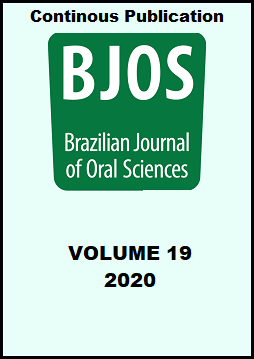Abstract
Aim: To explore socioeconomic, educational and research factors associated with dental research productivity at the state level in Brazil. Methods: The authors used the Scopus database to identify dental articles published from 2006 to 2016 associated with Brazilian universities at the state level. Several social, economic, educational and research structure variables were obtained from the census and National Research Council to predict the rate of articles per 100 thousand inhabitants among the 27 Brazilian states. Rates were fitted in linear weighted least-squared regression with stepwise technique. Twenty-two variables were grouped in six blocks (social, economic, general education, dental education, research workforce and structure). Results: A total of 21189 articles were published, and the state of São Paulo accounted for 46%, followed by Rio Grande do Sul with 9.4%; four states did not publish any articles. There were an average (± standard deviation) of 2.6 (±1.98) published articles per 100 researchers and 13.4 (±9.6) articles per 100 thousand inhabitants. Research structure and workforce explained 92.4% and 87.2% of state variability, respectively, while the final model explained 94.5%. One extra PhD and one extra undergraduate researcher per 100 thousand inhabitants were associated with 11.3 more and 3.5 fewer articles, respectively, while every 10 points (range 0-100) on the Human Development Index (Education Component) was associated with 3.3 more articles. Conclusion: State scientific output has several associated factors, but research workforce and general education variables seem to be good predictors. Large disparities among state research outputs have been described and must be addressed by research and development policies.
References
United Nations. The Sustainable Development Goals Report. United Nations. 2016.
Pastor JM, Serrano L. The determinants of the research output of universities: specialization, quality and inefficiencies. Scientometrics. 2016 Nov 20;109(2):1255–81.
World Bank. Databank: World Development Indicators 2016 [Internet]. 2010. Available from: http://databank.worldbank.org
Soares CJ, Bönecker MJS, Dias KRHC. Documento de Área: Área 18 – Odontologia. Brasilia: Coordenação de Aperfeiçoamento de Pessoal de Nível Superior; 2016. p. 49.
Celeste RK, Broadbent JM, Moyses SJ. Half-century of Dental Public Health research: bibliometric analysis of world scientific trends. Community Dent Oral Epidemiol. 2016 Dec 1;44(6):557–63.
Nadanovsky P. Growth in Brazilian scientific output in public health dentistry. Cad Saude Publica. 2006;22:886–7.
Allareddy V, Allareddy V, Rampa S, Nalliah RP, Elangovan S. Global Dental Research Productivity and Its Association With Human Development, Gross National Income, and Political Stability. J Evid Based Dent Pract. 2015;15(3):90–6.
Pulgar R, Jiménez-Fernández I, Jiménez-Contreras E, Torres-Salinas D, Lucena-Martín C. Trends in World Dental Research: An overview of the last three decades using the Web of Science. Clin Oral Investig. 2013;17(7):1773–83.
Daizen T. Research productivity. In: Teichler U, Arimoto A, Cummings WK, editors. The Changing Academic Profession in Japan. New York: Springer; 2015. p. 149–67.
Lee S, Bozeman B. The impact of research collaboration on scientific productivity. Vol. 35, Social Studies of Science. 2005. p. 673–702.
Alghanim SA, Alhamali RM. Research productivity among faculty members at medical and health schools in Saudi Arabia: Prevalence, obstacles, and associated factors. Saudi Med J. 2011;32(12):1297–303.
Dundar H, Lewis DR. Determinants of research productivity in Higher Edcuation. Res High Educ. 1998;43(3):309–29.
Morales DX, Grineski SE, Collins TW. Increasing research productivity in undergraduate research experiences: Exploring predictors of collaborative faculty-student publications. CBE Life Sci Educ. 2017;16(3):1–9.
King DA. The scientific impact of nations. Vol. 430, Nature. 2004. p. 311–6.
Programa das Nações Unidas para Desenvolvimento. Atlas do Desenvolvimento Humano do Municípios no Brasil. Belo Horizonte: Programa das Nações Unidas para Desenvolvimento, Instituto de Pesquisa Econômica Aplicada, Fundação João Pinheiro; 2013. p. http://atlasbrasil.org.br/2013/pt/.
Morgenstern H. Uses of ecologic analysis in epidemiologic research. Am J Public Heal. 1982;72(12):1336–44.
Celeste RK, Warmling CM. Produção bibliográfica brasileira da Saúde Bucal Coletiva em periódicos da saúde coletiva e da odontologia. Cien Saude Colet. 2014 Jun;19(6):1921–32.
Cross D, Thomson S, Sinclair A. Research in Brazil: A report for CAPES (InCites). Clarivate Analytics; 2018. p. 73.
Kanoute A, Faye D, Bourgeois D. Current status of oral health research in Africa: an overview. Int Dent J. 2012 Dec;62(6):301–7.
Correa RL, Nascimento DE do. Disparidades Estaduais E Regionais Em Ciência, Tecnologia e Inovação no Brasil. In: Anais do I Congresso Nacional de Mestrados Profissionais em Administracao Publica [Internet]. Curitiba; 2016 [cited 2018 Sep 6]. p. 12. Available from: http://www.profiap.org.br/profiap/eventos/2016/i-congresso-nacional-de-mestrados-profissionais-em-administracao-publica/anais-do-congresso/40671.pdf
Neto M. As fundações estaduais de amparo à pesquisa e o desenvolvimento da ciência, tecnologia e inovação no Brasil. Rev USP. 2011;(89):174–89.
Avellar SOC. Migração interna de mestres e doutores no Brasil : algunas considerações. RBPG. 2014;11(24):429–57.
Avellar SOC. Mobilidade espacial de mestres e doutores no Brasil : 1975-2010. Universidade Estadual de Campinas; 2015.
The Brazilian Journal of Oral Sciences uses the Creative Commons license (CC), thus preserving the integrity of the articles in an open access environment.


